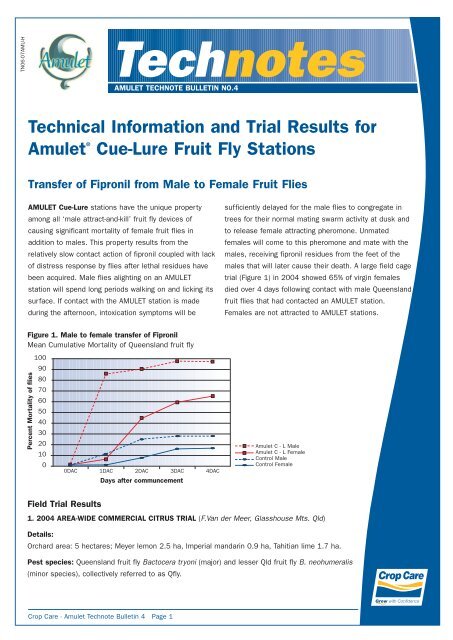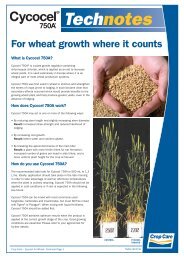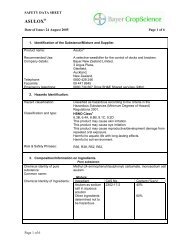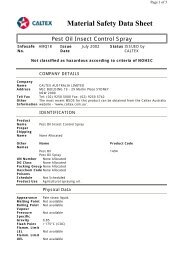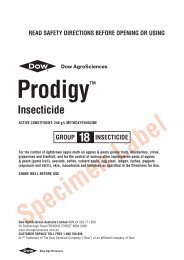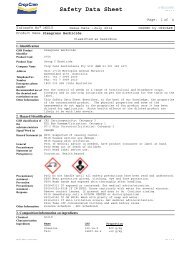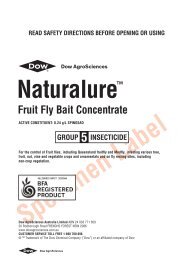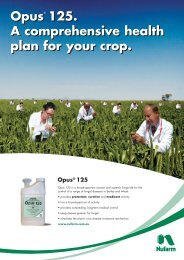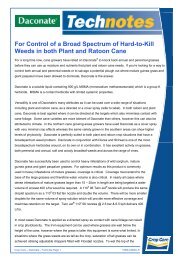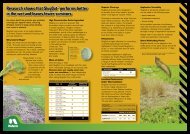Amulet Technote No 4 (Page 1) - Pest Genie
Amulet Technote No 4 (Page 1) - Pest Genie
Amulet Technote No 4 (Page 1) - Pest Genie
- No tags were found...
You also want an ePaper? Increase the reach of your titles
YUMPU automatically turns print PDFs into web optimized ePapers that Google loves.
TN06-07AMU-H<strong>Technote</strong>sAMULET TECHNOTE BULLETIN NO.4Technical Information and Trial Results for<strong>Amulet</strong> ®Cue-Lure Fruit Fly StationsTransfer of Fipronil from Male to Female Fruit FliesAMULET Cue-Lure stations have the unique propertyamong all ‘male attract-and-kill’ fruit fly devices ofcausing significant mortality of female fruit flies inaddition to males. This property results from therelatively slow contact action of fipronil coupled with lackof distress response by flies after lethal residues havebeen acquired. Male flies alighting on an AMULETstation will spend long periods walking on and licking itssurface. If contact with the AMULET station is madeduring the afternoon, intoxication symptoms will besufficiently delayed for the male flies to congregate intrees for their normal mating swarm activity at dusk andto release female attracting pheromone. Unmatedfemales will come to this pheromone and mate with themales, receiving fipronil residues from the feet of themales that will later cause their death. A large field cagetrial (Figure 1) in 2004 showed 65% of virgin femalesdied over 4 days following contact with male Queenslandfruit flies that had contacted an AMULET station.Females are not attracted to AMULET stations.Figure 1. Male to female transfer of FipronilMean Cumulative Mortality of Queensland fruit flyPercent Mortality of flies10090807060504030201000DAC 1DAC 2DAC 3DAC 4DACDays after communcement<strong>Amulet</strong> C - L Male<strong>Amulet</strong> C - L FemaleControl MaleControl FemaleField Trial Results1. 2004 AREA-WIDE COMMERCIAL CITRUS TRIAL (F.Van der Meer, Glasshouse Mts. Qld)Details:Orchard area: 5 hectares; Meyer lemon 2.5 ha, Imperial mandarin 0.9 ha, Tahitian lime 1.7 ha.<strong>Pest</strong> species: Queensland fruit fly Bactocera tryoni (major) and lesser Qld fruit fly B. neohumeralis(minor species), collectively referred to as Qfly.Crop Care - <strong>Amulet</strong> <strong>Technote</strong> Bulletin 4 <strong>Page</strong> 1
Crop Care - <strong>Amulet</strong> <strong>Technote</strong> Bulletin 42. 2002 AREA-WIDE CITRUS TRIAL (Coochin Creek Farms Ltd, Roy’s Rd, Beerwah Qld).The trial was located on a 250 ha citrus orchard in 3 navel orange blocks each with separate treatments as follows:AMULET Gel protein bait @ 250 mL/100 m row at 7-day intervals.AMULET Cue-Lure fruit fly stations @ 25 m grid + AMULET Gel protein bait as above.GF120 Naturalure @ 375 mL/100 m row (7.5 L/ha) at 7-day intervals.ResultsAMULET stations + AMULET Gel protein bait sprays reduced fruit fly populations within the treated area significantlybetter than protein bait sprays alone.Figure 4. Number of Male QfliesCoochin Creek Farms, via Beerwah Qld504540353025201510501 2 3 4 5 6 7 8Weeks of treatmentQflies/trap/week3. 2002 Area-wide Grape Trial.Significant commercial losses may occur from Qfly attack oftable grapes, especially white varieties on which stings arevisually obvious. Although only a small percentage of eggsin stings may produce live larvae causing the fruit to rot,marked fruit will result in market rejection.GF120<strong>Amulet</strong> GEL<strong>Amulet</strong> MAT + GELPhoto 1. Crop damage from Qfly ‘stings’on white Muscat grapesFigure 5. Population response to <strong>Amulet</strong> Cue-Lure fruit fly stationsNumber of Qflies/trap/week300250200150100500<strong>Amulet</strong> Mats placed in vineyardon 25 m grid patternpre-treat Wk1 Wk2 Wk3 Wk4 Wk5 Wk6Weeks of treatment® <strong>Amulet</strong> is a registered trademark of BASF. ≈ Registered trademardk of Dow Agro AgroScThis publication is a guide only and no substitute for professional or expert advice. The product label should be consultedbefore use of any of the products referred to in this publication. Crop Care Australia Pty Ltd shall not be liable for anyresults, loss, or damage whatsoever, whether consequential or otherwise through the use or application of productsand/or materials referred to herein.© Copyright 2006. Crop Care Australasia Pty Ltd ACN 061 362 347Before using, always read the product label.More information: Contact your local Crop Care distributorCustomer serviceAustralia-wide: 1800 111 454Fax: (07) 3867 9110www.cropcare.com.auCrop Care - <strong>Amulet</strong> <strong>Technote</strong> Bulletin 4 <strong>Page</strong> 32002 Area-wide table grape trial -Baccaria Bros., Doolandella, Brisbane®
Figure 2. Qld fruit fly populations2004 Field Trial: F. Van der Mear, Glasshouse Mountains Qld , Meyer lemon orchard350.0Crop Care - <strong>Amulet</strong> <strong>Technote</strong> Bulletin 4Flies per trap per week300.0250.0200.0150.0100.050.00.0<strong>Amulet</strong> MatTreatment commencedWeekly protein sprays<strong>Amulet</strong> MatRe-treatment commencedWeekly protein spraysPer treatWk1Wk2Wk3Wk4Wk5Wk6Wk7Wk8Wk9Wk10Wk11Wk12Wk13Wk14Wk15Wk16Wk17Wk18Wk19Wk20Wk21Wk22Wk23Wk24Wk25Wk26Wk27Wk28Wk29Wk30Wk31Wk32Wk33Wk34Wk35Wk36Wk37Wk38Mar Apr May June July August Sept Oct <strong>No</strong>vWeeks of TreatmentForest check malesIn-trial malesIn-trial femalesAMULET stations were placed in citrus trees throughoutthe orchard on a 25 m grid (16/ha) on 4 March andreplaced on 10 August. Protein bait sprays alsocommenced on 4 March, but stopped during winter andrecommenced 1st week of August. Fruit fly traps werelocated within the orchard area and in bushland 200-500m from the trial boundary one week prior to start oftreatments to determine the area population and weremonitored weekly to end of <strong>No</strong>vember. Assessment offruit infestation was conducted in 2 periods during peakfruit fly activity by inspection of 500 mature (marketready) Meyer lemons each week, recording percent‘stung’ fruit.ResultsFruit fly populationsFollowing placement of AMULET stations, male Qflynumbers crashed to 3/trap/week in the orchardcompared to 27/t/w in the adjacent bushland (Figure2) and thereafter did not exceed 5/t/w for 28consecutive weeks. During the treatment periodorchard populations averaged approximately 12 timesless than those trapped in nearby bushland.Trapping data showed there were 3 major surges ofdistrict-wide migration by Qfly in late winter and springwith each one becoming larger (up to 300/trap/week),but AMULET stations and protein bait spray treatmentswithin the trial area were able to mop up virtually allflies as they entered the orchard. Female Qflynumbers were kept at a similarly low level within thetrial by the protein bait sprays, probably augmentedby transfer of fipronil by males.Fruit damageTreatments took 3-4 weeks to eliminate residentfemales in autumn and damage then dropped to0-3% prior to winter (Figure 3). Spring pressurewas particularly severe, but percent stung fruitwas held to


